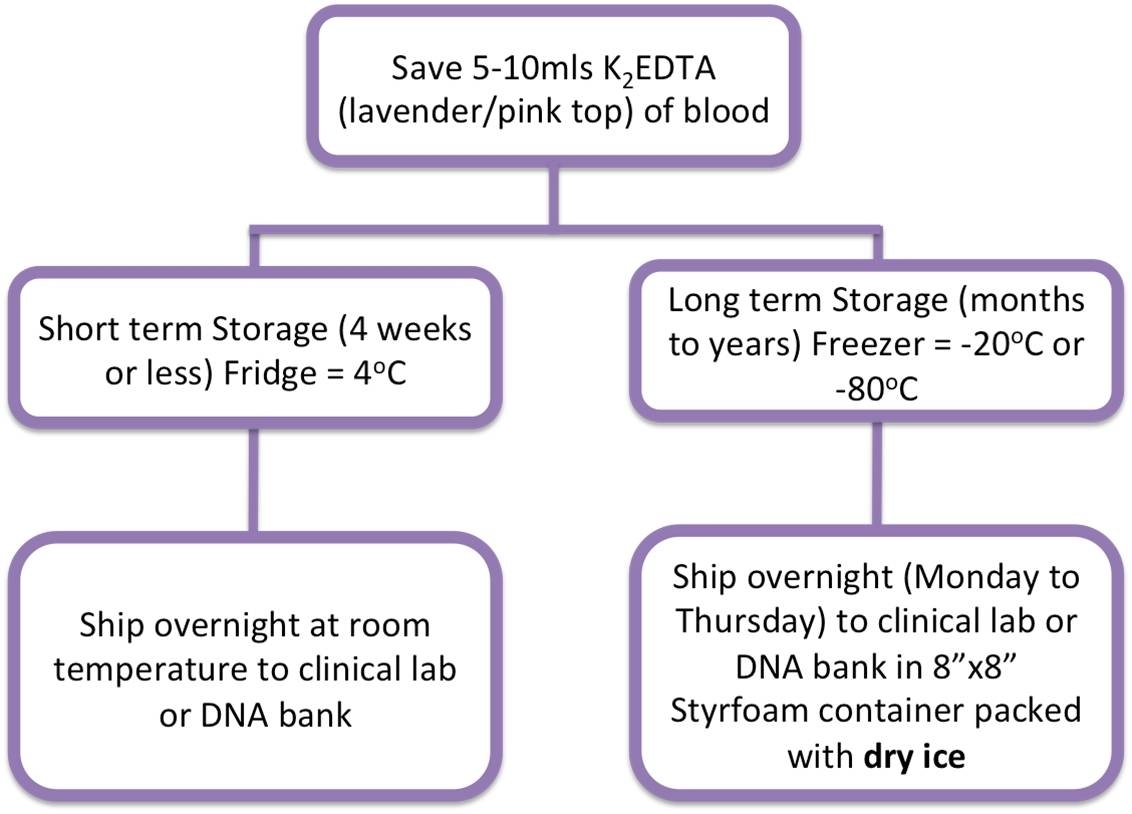If Cardiac Disease is Suspected
Preferred Sample(s)
- Blood (Purple Top/EDTA tube)
- 7 to 10 ccs of fresh blood in pink/lavender/EDTA blood tubes (see diagram below)
Other Possible Sample(s)*
- Blood Spot Cards (only some labs will accept and type of testing available may be limited)
- Some Frozen Tissue
* Other types of samples that may be acceptable for genetic testing may depend on the type of test needed and the diseases being interrogated.
How Do I Save a Blood Sample for Potential Genetic Testing?

Once I Save the Blood Sample What Do I Do With It?
- Storage: Once the correct sample is saved it must be stored appropriately to ensure the integrity of the DNA is preserved. If the blood is to be stored short term (less than 4 weeks after autopsy) the sample should be kept in a refrigerator (4°C). For longer storage (months to years), samples should ideally be moved to a -20°C to -70°C freezer and remain there until they can be shipped to an appropriate laboratory or DNA bank.
- Shipping: Once a sample is frozen, it should not be thawed until arriving in the genetic testing laboratory.
- DNA quality is just as dependent on the manner in which a sample is sent as the type of sample it is extracted from.
- To prevent thawing, all frozen samples should be packed in a Styrofoam container packed tightly with dry ice.
- Fresh samples (less than 24 hours old) may be shipped at room temperature.
- All samples, frozen and fresh, should be packaged according to hazardous material guidelines and shipped overnight by a courier or reliable shipping company to either a DNA bank or Clinical Genetic Testing Laboratory according to the decision of the family or healthcare professional.
- Payment: When such testing is initiated by an agency outside of the investigating medical examiner or coroner, shipping materials and costs of delivery should be arranged through the laboratory and the family.
If Metabolic Disease is Suspected
Please note that due to the nature of metabolic disease some of the samples listed below can be used for metabolic testing but are not suitable for DNA sequencing tests. If you have any questions about the most appropriate sample(s) to save for testing please email postmortem@nsgc.org.
Bodily Fluids
- Blood, bile and urine spots for metabolic testing
- Vitreous electrolytes, glucose, VUN, creatinine
- Saliva for DNA
- Microbiology specimens for culture/PCR when indicated
Tissue
- Liver tissue – 40-50 g open biopsy, flash frozen
- Skin biopsy, 5 mm x 5 mm specimen, for fibroblast culture
- Retain as much brain tissue as possible in formalin
- Microscopic sections (in addition to routine sections of heart, lung, etc.)
- Representative sections of brain including
- Bilateral hippocampus (include gross description of symmetry)
- Temporal lobe cortex near hippocampus
- Midbrain
- Pons
- Rostral medulla
- Cerebellum including dentate
- Basal ganglia
- Watershed cortex
- Thymus
- Gastro-esophageal junction for signs of GER